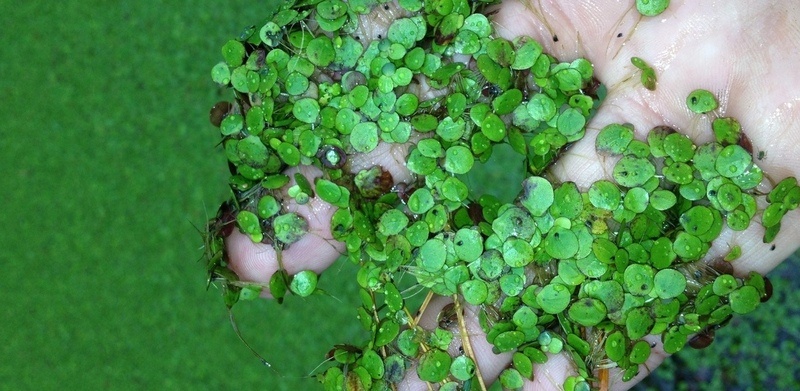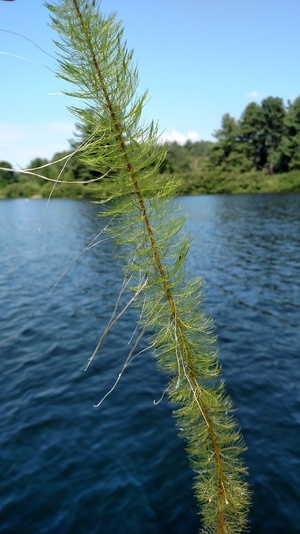A Homeowner’s Guide to Aquatic Hitchhikers
March 1st, 2018

Do you know what costs homeowner’s associations, small communities and government agencies over 120 billion dollars annually? The answer is invasive species. Far beyond the monetary costs, invasive species create unsightly, unbalanced and unhealthy aquatic ecosystems. Unfortunately, human activity is responsible for most infestations. Whether you’re a part of a lake community, live near a stormwater pond or even own a decorative backyard water garden, we all play pivotal roles in spreading—but also preventing—invasive aquatic species.
Education is the first step of prevention and can go a long way in keeping these unwanted species out of neighboring waterbodies. Many invasive plant infestations that we manage today could have been prevented by exercising caution and following a few proactive steps:
 Keep your water features contained, and prevent contents from entering nearby waterbodies. Many invasive species spread through fragmentation, meaning a small piece of the aquatic plant can cause an entirely new infestation in a nearby waterbody.
Keep your water features contained, and prevent contents from entering nearby waterbodies. Many invasive species spread through fragmentation, meaning a small piece of the aquatic plant can cause an entirely new infestation in a nearby waterbody.- Do not cultivate non-native species on your property. Not all invasive species are unsightly; plants like purple loosestrife are often sought for their pretty purple flowers, but they can wreak havoc on native aquatic plant populations.
- Do not dispose of old aquarium plants by dumping them into local waterways, which will ultimately lead to a lake or pond. This is exactly how watermilfoil was introduced to North America. Now, there are infestations in nearly every US state.
- Help limit nutrient loading in nearby lakes and ponds by properly disposing of dog droppings, sweeping up grass clippings and reducing fertilizer use on lawns and gardens. These factors are all sources of organic nutrients, which can fuel invasive aquatic plant growth after entering lakes and ponds through stormwater runoff.
- Regularly monitor the vegetation in your pond. It is important to identify and properly remove any invasive species present as to prevent it from spreading. If you’re unsure of a species, a professional lake manager can help with identification and offer sustainable management tips.
- Get to know the potential invasive species that may appear in your area. Keep an eye out for them while on the water and volunteer with the lake/pond association as a “weed watcher” or implement a “Boat Ramp Monitor Program” to limit the potential of aquatic hitchhikers.
There are several courses of action that can be taken to prevent an invasive species from entering a new body of water, but what happens if an invasive species is already present in the waterbody? If this is a pioneer infestation, be sure to note the exact location, take a photo of the specimen, and report it to the proper authorities. If a sample of the specimen is collected, be sure to properly dispose of it before leaving the waterbody. The transport of any invasive species is illegal in many jurisdictions, and may require a special permit. Once an infestation has been confirmed, management options should be considered promptly. Reach out to the owner, lake association or state agency and suggest they consult their lake management professionals.
Invasive species impede our natural ecosystems and impose substantial annual costs to property owners, community associations and city governments. It is an issue that will only get worse if no action is taken and it is up to everybody who uses, lives on and cares for our waterbodies to make every effort possible to prevent infestations. Prevention is the best method of defense against an invasive species. If unable to prevent an infestation of invasive species, we must rely on professional management, early detection and rapid response in order to maintain healthy aquatic ecosystems.
Contact the experts at 888-480-5253 for all of your lake, pond, wetland and fisheries management needs.
SOLitude Lake Management is an environmental firm committed to providing full-service solutions that improve water quality, preserve natural resources, and reduce our environmental footprint. Our services include lake, pond, wetland and fisheries management programs, algae and aquatic weed control, mechanical harvesting, hydro-raking, installation and maintenance of fountains and aeration systems, water quality testing and restoration, bathymetry, lake vegetation studies, biological assessments, habitat assessments, invasive species management and nuisance wildlife management. Services, consulting and aquatic products are available to clients nationwide, including homeowners associations, multi-family and apartment communities, golf courses, commercial developments, ranches, private landowners, reservoirs, recreational and public lakes, municipalities, parks, and state and federal agencies. Learn more about SOLitude Lake Management and purchase products at www.solitudelakemanagement.com.










